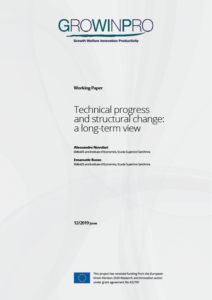Along the development path, countries experience large transformations in their economic structure as productive resources move towards different economic activities. “Modern economic growth” is also associated with a self-sustained process of technical change which leads to the emergence of new products and sectors characterized by different scopes for productivity gains and demand growth. In this paper we study the interactions between structural change and technological progress from a long-term perspective. We first analyze the secular patterns of structural change across agriculture, manufacturing and services using historical data in the attempt to test some broad conjectures concerning sectoral reallocations at different stages of development (i.e. the so-called Petty-Clark law) and discuss the specific role of manufacturing as an engine of growth. Second, we provide an overview of the literature on sectoral innovation patterns as well as of recent evidence linking structural transformations and sector-specific technological opportunities to aggregate productivity growth. In the final part we present productivity decompositions using a sectoral innovation taxonomy to study the contribution of different groups of activities characterized by heterogeneous innovation patterns. Our results suggest that structural change towards knowledge-intensive activities provides a source of productivity growth in both developing and advanced countries. In turn, this points at the need for a more disaggregated analysis of structural change to capture the diversity in the rate and direction of technical progress across sectors.

 Technical progress and structural change: a long-term view
Technical progress and structural change: a long-term view